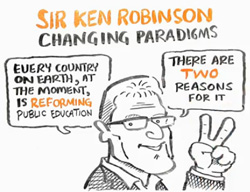 In this talk from RSA Animate, Sir Ken Robinson lays out the link between 3 troubling trends: rising drop-out rates, schools’ dwindling stake in the arts, and ADHD. An important, timely talk for parents and teachers.
In this talk from RSA Animate, Sir Ken Robinson lays out the link between 3 troubling trends: rising drop-out rates, schools’ dwindling stake in the arts, and ADHD. An important, timely talk for parents and teachers.
Creativity expert Sir Ken Robinson challenges the way we’re educating our children. He champions a radical rethink of our school systems, to cultivate creativity and acknowledge multiple types of intelligence.
The animation in the video below is very good and illustrates his points well. The transcript of his lecture is also include underneath the video.
Changing Education Paradigms
by Sir Ken Robinson
Every country on earth at the moment is reforming public education. There are two reasons for it. The first of them is economic. People are trying to work out “how do we educate our children to take their place in the economies of the 21st century”? How do we do that, given that we can’t anticipate what the economy will look like at the end of next week as the recent turmoil is demonstrating? How do we do that?
The second, though, is cultural. Every country on earth is trying to figure out how do we educate our children so they have a sense of cultural identity and so that we can pass on the cultural genes of our communities while being part of the process of globalization; how do we square that circle? The problem is, they’re trying to meet the future by doing what they did in the past, and on the way they’re alienating millions of kids who don’t see any purpose in going to school. When we went to school, we were kept there with a story which is if you worked hard and did well, and got a college degree, you would have a job. Our kids don’t believe that! And they’re right not to, by the way.
You’re better having a degree than not, but it’s not a guarantee anymore, and particularly not if the route to it marginalizes most of the things that you think are important about yourself. And so people say we have to raise standards if this is a breakthrough. You know, like, really? Yes! We should! Why would you lower them? I haven’t come across an argument that persuades me of lowering them. But raising them, of course we should raise them.
The problem is, the current system of education was designed and conceived and constructed for a different age. It was conceived in the intellectual culture of the enlightenment and in the economic circumstances of the industrial revolution. Before the middle of the 19th century there were no systems of public education. Not really… I mean you could get educated by Jesuits, you know, if you had the money. But public education, paid for from taxation, compulsory to everybody, and free at the point of delivery, that was a revolutionary idea. And many people objected to it. They said “It’s not possible for many street kids, working class children, to benefit from public education. They’re incapable of learning to read and write, and why are we spending time on this?”
So there’s also built into it a whole series of assumptions about social structure and capacity. It was driven by an economic imperative of the time, but running right through it was an intellectual model of the mind, which was essentially the Enlightenment view of intelligence that real intelligence consists in this certain type of reductive reasoning and a knowledge of the classics, originally, what we’ve come to think of as academic ability. And this is deep in the gene pool of public education, that there are really two types of people, academic and non-academic, smart people and non-smart people. And the consequence of that is that many brilliant people think they’re not because they’ve been judged against this particular view of the mind.
So we have twin pillars: economic and intellectual. And my view is that this model has caused chaos in many people’s lives. It’s been great for some; there have been people who have benefited wonderfully from it. But most people have not. Instead they suffer this: this is the modern epidemic, and it’s as misplaced, and it’s as fictitious: this is the plague of ADHD. Now this is a map of the instance of ADHD in America or prescriptions for ADHD. Don’t mistake me; I don’t mean to say there is no such thing as Attention-Deficit Disorder. I’m not qualified to say if there is such a thing. I know that a great majority of psychologists and pediatricians think there is such a thing. But it’s still a matter of debate. What I do know for a fact is it’s not an epidemic. These kids are being medicated as routinely as we had our tonsils taken out, and on the same whimsical basis and for the same reason: medical fashion.
Our children are living in the most intensive stimulating period in the history of the earth. They’re being besieged with information and coerced for attention from every platform: computers, from iPhones, from advertising hoardings, from hundreds of television channels. And we’re penalizing them now for getting distracted. From what? Boring stuff. At school, for the most part. It seems to me not a coincidence, totally, that the instance of ADHD has risen in parallel with the growth of the standardized testing. Now these kids are being given Ritalin and Aderol and all manner of things, often quite dangerous drugs, to get them focused and calm them down. But according to this, Attention-Deficit Disorder increases as you travel east across the country. People start losing interest in Oklahoma, they can hardly think straight in Arkansas, and by the time they get to Washington they’ve lost it completely (and there are separate reasons for that, I believe). It’s a fictitious epidemic.
If you think of it, the arts, and I don’t say this exclusively to the arts, I think it’s also true of science and of maths, but I say about arts particularly because they are the victims of this mentality currently, particularly. The arts especially address the idea of aesthetic experience. An aesthetic experience is one in which your senses are operating at their peak, when you are present in the current moment, when you are resonating with the excitement of this thing that you’re experiencing, when you are fully alive. An anesthetic is when you shut your senses off and deaden yourself to what’s happening. And a lot of these drugs are that. We are getting our children through education by anesthetizing them. And I think we should be doing the exact opposite. We shouldn’t be putting them to sleep, we should be waking them up to what they have inside of themselves! But the model we have is this: I believe we have a system of education that is modeled on the interests of industrialism and in the image of it.
I’ll give you a couple of examples. Schools are still pretty much organized on factory lines: ringing bells, separate facilities, specialized into separate subjects. We still educate children by batches, you know, we put them through the system by age group. Why do we do that? Why is there this assumption that the most important thing kids have in common is how old they are? You know, it’s like the most important thing about them is their date of manufacture. Well, I know some kids who are are much better than other kids at the same age in different disciplines, or at different times of the day, or better in smaller groups than large groups, or sometimes they want to be on their own. If you’re interested in the model of learning you don’t start from this production line mentality. It’s essentially about conformity and it’s increasingly about that as you look at the growth of standardized testing and standardized curricula. And it’s about standardization.
I believe we’ve got to go in the exact opposite direction. That’s what I mean about changing the paradigm. There was a great study done recently of divergent thinking. It was published a couple years ago. Divergent thinking isn’t the same thing as creativity. I define creativity as the process of having original ideas that have value. Divergent thinking isn’t a synonym but it’s an essential capacity for creativity. It’s the ability to see lots of possible answers to a question, lots of possible ways of interpreting a question, to think (what Ed De Bond would probably call) laterally, to think not just in linear or convergent ways, to see multiple answers, not one! So, I mean, there are tests for this. One kind of cod example would be people might be asked to say “how many uses can you think of for a paper clip?” All those routine questions. Most people might be able to come up with ten or fifteen. People who are good at this might come up with two hundred. And they do that by saying, “well, could the paper clip be two hundred feet tall and made out of foam rubber?” You know, like “does it have to be a paper clip as we know it, Jim”.
Now there are tests for this, and they gave them to fifteen hundred people in a book called “Break Point and Beyond”. And on the protocol of the test, if you scored above a certain level, you’d be considered to be a genius at divergent thinking. Okay? So my question to you is, what percentage of the people tested, of the fifteen hundred, scored at genius level for divergent thinking? Now you need to know one more thing about them: these were kindergarten children. So what do you think? What percentage at genius level? Eighty? You think eighty? Okay. Ninety-eight percent. Now, the thing about this was it was a longitudinal study. So they re-tested the same children five years later, age of eight to ten. What do you think? Fifty? They re-tested them again five years later at ages thirteen to fifteen. You can see a trend here, can’t you?
Now, this tells an interesting story, because you could have imagined it going the other way, couldn’t you? You start off not being very good, but you get better as you get older. But this shows two things. One is, we all have this capacity, and two, it mostly deteriorates. Now a lot of things have happened to these kids as they’ve grown up. A lot. But one of the most important things that happened to them, I am convinced, is that by now, they have become educated. They know they’ve spent ten years in school being told there’s one answer, it’s in the back. And don’t look! And don’t copy! Because that’s cheating! I mean, outside schools, that’s called collaboration, you know, but inside schools…
Now this isn’t because teachers want it this way, it’s just because it happens that way. It’s because it’s in the gene pool of education. We have to think differently about human capacity. We have to get over this old conception of academic, non-academic, abstract, theoretical, vocational… and see it for what it is, a myth. Second, you have to recognize that most great learning happens in groups, that collaboration is the stuff of growth. If you atomize people and separate them and judge them separately, we form a kind of disjunction between them and their natural learning environment. And thirdly, it’s crucially about the culture of our institutions, the habits of institution and the habitats that they occupy.

